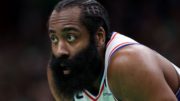It’s Oscars Week, which feels like as good a time as any to draw up the NBA storylines and characters which could double as Oscar nominees.
No NBA executive has a more interesting relationship with arcs than Philadelphia 76ers president Daryl Morey. Friday was the opening day of MIT’s Sloan Analytics Conference, the annual haven for stat geeks he co-founded after he left the Boston Celtics to join the Houston Rockets front office in 2006.
Last week, NBA Head of Basketball Operations Joe Dumars announced the league was investigating rule changes that could curtail the offensive explosion that’s seen the league-wide record for offensive rating being set six times in the last seven seasons.
The primary culprit was Morey, whose innovative views on analytics earned him the title of Dork Elvis. In his view, “Being mad about analytics is like being mad about gravity.”
Steph Curry conquered the league with his prowess shooting from downtown, but before the Splash Brothers decimated the league, Morey’s Manhattan Project in the Rio Grande Valley — home of the Rockets’ D-League affiliate — was the genesis of the modern NBA.
As Rockets general manager, Morey poached Chris Finch from Europe and empowered Nick Nurse, and appointed them as heads of his D-League experiment. Under Finch, Nurse, and Nurse’s successor Nevada Smith, the Vipers led the league in 3-pointers every season between 2010 and 2014, winning two D-League titles, leading the league in effective field goal percentage four out of six seasons, and in 3-pointers four consecutive seasons.
If the Vipers was Morey’s basketball’s covert hoops lab, the 2013-14 season was its Trinity Test. The 2013 Vipers took Morey’s dalliances with the three-point arc to another level. They attempted half as many midrange attempts as the D-League’s penultimate midrange shooting offense and took 12 more triples than the second-most active team behind the arc. The gap between the Vipers and the next-most active three-point-oriented offense was as vast as the gap between second and 11th.
From Houston’s Moneyball era to Basketball’s Manhattan Project to James Harden playing MoreyBall and finally banishment in Philadelphia building a small ball squad around one of the NBA’s premier bigs, there’s plenty of material there if Christopher Nolan ever decides to make a turn from his obsessions with physics towards basketball analytics’ forefathers. Morey’s three-act legacy as another vainglorious Prometheus who changed his field for better or worse could use some contextualizing.
For early adopters of advanced analytics eFG%= (FGM + 0.5 * 3PM)/FGA is hoops’ E = mc^2.
I’d like to say it wasn’t Rocket science, but for Morey it was. In the 2010s, Morey simultaneously put the J in Robert Oppenheimer as the father of the NBA’s jump shooting epoch. There’s still a contentious debate over who exactly originated one of the NBA’s most widely used formulas among modern stat geeks, but he was the original GM to optimize his organization’s talent acquisition through the application of advanced statistics which put a greater emphasis on the three-pointer. For a decade, it was a blinding success.
Once Morey acquired James Harden from Oklahoma City the success of Morey’s Rio Grande Valley experiment dictated the Rockets’ direction. Between 2014 and 2019 — Golden State’s peak — Houston attempted 3,000 more treys than the Warriors. During the 2014-15 season, the Rockets shot threes at a more prolific rate than the Dubs did en route to the title. In 2016, Golden State led the league in 3-point attempts for the first time, and Houston countered by hiring Mike D’Antoni, letting Dwight Howard walk, replacing him with Ryan Anderson, and signing Eric Gordon.
Howard’s dismissal signaled the official conversion to long-distance warfare and halted the more gritty low post combat that’s defined the previous 60 years of NBA basketball and sparked a Cold War behind the three-point arc that started as a territorial conflict between the Rockets and Warriors before spreading to the rest of the league.
The upgrade to D’Antoni was an outside-the-box coach willing to amplify Harden’s strengths. D’Antoni activated Harden into the premier heliocentric guard of this offensive age. Since entering the league, mid-range jump shooting proficiency was his defect. Together they assembled an H-Bomb around their reverse Melo. Harden thrived on Euro-stepping to the rim and taking step-back threes.
When Harden went nuclear, he was an H-Bomb, eviscerating defenses at unimaginable temperatures. But he also had meaner cold streaks in pressure situations than any superstar in the league. Harden and the Rockets played MoreyBall, but Curry and the Warriors produced swishes from deep like it was their biological imperative.
The culmination of Morey’s engineering was the 2016-17 Rockets who heaved 600 more treys than any team in league history — and collapsed with a 3-1 lead over Golden State in the Conference Finals. That’s not what Live by the 3, die by the 3 is supposed to mean, but the final comeuppance for the Morey era Rockets’ sins upon nature rolled through in Game 7 of the 2018 Western Conference Semifinals when Houston bricked 27-consecutive triples down the stretch.
If that wasn’t bad enough, Morey’s personal admiration for Harden transformed him into a victim of his own creation. Interpersonal relationships have never been Morey’s strength, but Harden is as much a legacy of Houston’s hollow MoreyBall era than anyone, winning three consecutive scoring titles, and never reaching a Finals. All those flashy hoopers that get casual fans or Mark Jackson grousing about Curry’s playground ball influence as they take stepback 30-footers are actually looking at mini-James Hardens. You don’t see weekend hoopers or AAU shot chuckers running off screens or diving to the rim off give-and-gos like Curry. Harden is the devil on every microwave scorer’s shoulders. Morey unlocked his idiosyncratic talents and encouraged it for better or for worse.
That didn’t stop Morey and ESPN’s visual stat whiz Kirk Goldsberry from proclaiming Harden as a better scorer than Michael Jordan. Following his resignation from the Rockets’ front office before the 2020 season, Morey thanked the city in a full-page ad that included a segue — in bold — that specifically thanked Harden.
“James Harden changed my life,” wrote Morey. “He not only transformed my life but also revolutionized the game of basketball — and continues to do so — like almost no one has before. The game is played differently because of James, and on every playground in the world, the next generation of talent is studying and imitating his game.”
Morey’s next act as Philadelphia’s president of Basketball Operations led to a reunion with an older, thicker, slow-twitch version of Harden. For a season and a half, Harden was superb as a supplement to reigning MVP Joel Embiid.
You know the story by now. A routine contract after the season dispute spilled out into open conflict when Harden announced from a packed gym in China that “Daryl Morey is a liar and I will never be a part of an organization that he’s a part of.
Harden had to have felt a cosmic kinship to Lewis Strauss sabotaging Oppenheimer over a petty grievance. Thrusting a shiv into the backs of his front office and teammates is Harden’s M.O. and Morey found out he isn’t immune when he didn’t throw $300 million at Harden’s feet or trade him to the Clippers overnight. When the going gets tough, Harden vaporizes relationships, potential title teams, and even entire in-game possessions. He is basketball death, the destroyer of teams. Morey discovered that every creator is eventually destroyed by his own Frankenstein.
Find DJ Dunson on X: @cerebralsportex
Original source here
#Daryl #Morey #Oppenheimer #NBAs #nuclear #offensive #age





